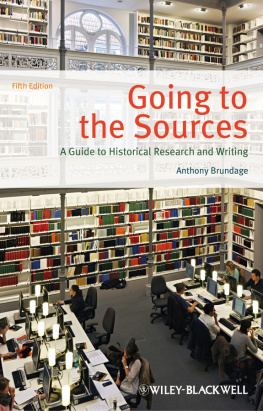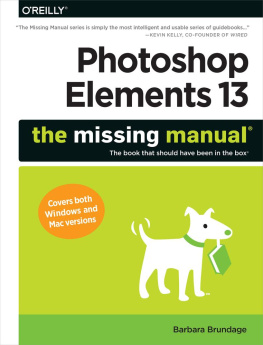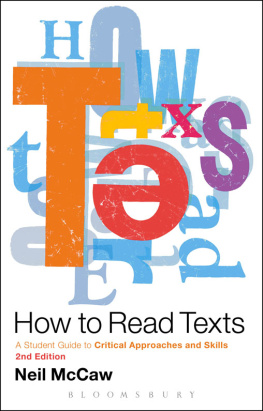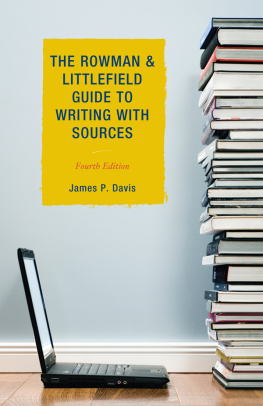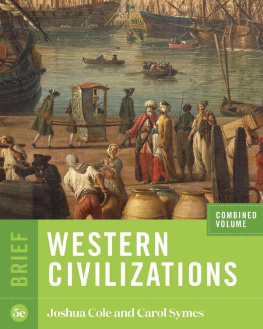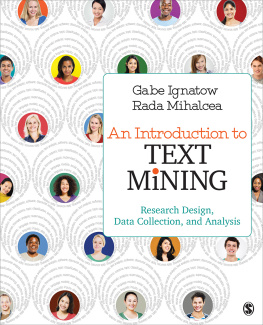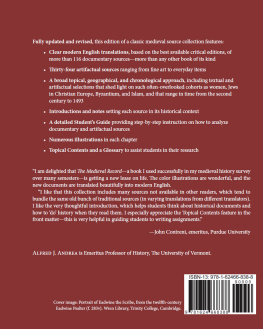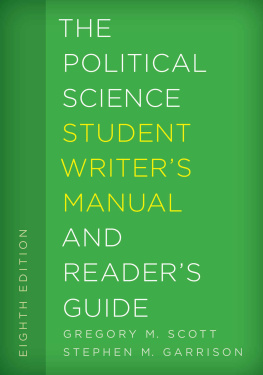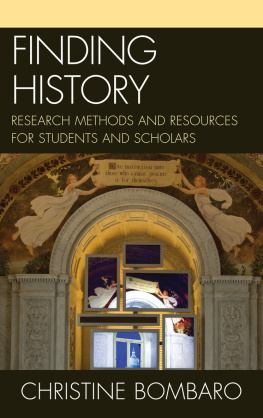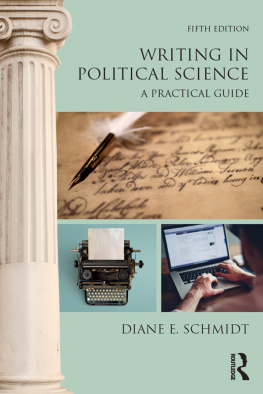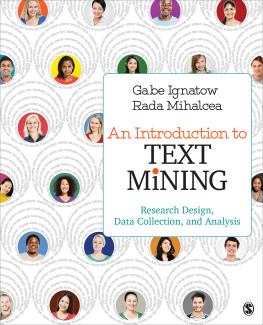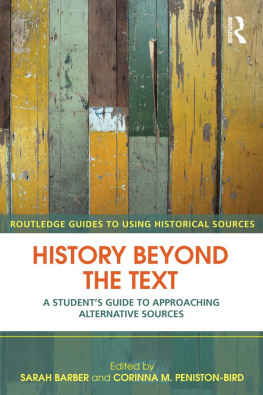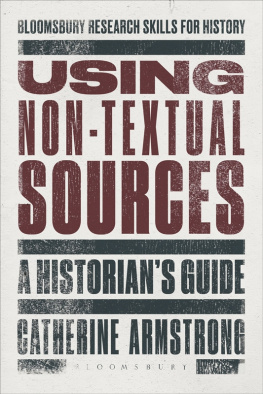
This fifth edition first published 2013
John Wiley & Sons, Ltd.
Edition history: Harlan Davidson, Inc. (1e, 1989; 2e, 1997; 3e, 2002; 4e, 2008)
Harlan Davidson, Inc. was acquired by John Wiley & Sons in May 2012.
Registered Office
John Wiley & Sons Ltd., The Atrium, Southern Gate, Chichester, West Sussex, PO19 8SQ, UK
Editorial Offices
350 Main Street, Malden, MA 021485020, USA
9600 Garsington Road, Oxford, OX4 2DQ, UK
The Atrium, Southern Gate, Chichester, West Sussex, PO19 8SQ, UK
For details of our global editorial offices, for customer services, and for information about how to apply for permission to reuse the copyright material in this book please see our website at www.wiley.com/wiley-blackwell.
The right of Anthony Brundage to be identified as the author of this work has been asserted in accordance with the UK Copyright, Designs, and Patents Act 1988.
All rights reserved. No part of this publication may be reproduced, stored in a retrieval system, or transmitted, in any form or by any means, electronic, mechanical, photocopying, recording or otherwise, except as permitted by the UK Copyright, Designs, and Patents Act 1988, without the prior permission of the publisher.
Wiley also publishes its books in a variety of electronic formats. Some content that appears in print may not be available in electronic books.
Designations used by companies to distinguish their products are often claimed as trademarks. All brand names and product names used in this book are trade names, service marks, trademarks or registered trademarks of their respective owners. The publisher is not associated with any product or vendor mentioned in this book. This publication is designed to provide accurate and authoritative information in regard to the subject matter covered. It is sold on the understanding that the publisher is not engaged in rendering professional services. If professional advice or other expert assistance is required, the services of a competent professional should be sought.
Library of Congress Cataloging-in-Publication Data
Brundage, Anthony, 1938
Going to the sources : a guide to historical research and writing / Anthony Brundage. Fifth edition.
pages cm
Includes bibliographical references and index.
ISBN 978-1-118-51531-0 (paperback : alkaline paper) 1. HistoryMethodology. 2. HistoryResearch. 3. HistoryResearchData processing. 4. Historiography. I. Title.
D16.B893 2013
907.2dc23
2012036173
A catalog record for this book is available from the British Library.
Cover image: Utrecht University Library Rene de Wit Rene de Wit/Arcaid/Corbis
Cover design by Simon Levy
To My Students
Preface to the Fifth Edition
This book developed out of a course on history methods that I have taught to upper division history majors for many years. As anyone who has taught a methodology course can attest, it can be either a uniquely rewarding or a deeply frustrating experience; usually it is both. Typically students approach the course with some apprehension. Up to this point their academic encounters with history have been chiefly in the form of lecture-discussion courses, a format with which they feel relatively secure. In the History Methods class they suddenly find themselves on unfamiliar terrain, confronted with new, sometimes perplexing challenges. Fortunately, often mingled with this apprehension is a sense of excitement about the prospect of achieving new levels of understanding the discipline, as well as of acquiring a new set of research and writing skills. It was in the hope of fostering the excitement, allaying the apprehension, and developing these skills that I undertook the writing of this book.
Central to my own sense of the excitement of history is an appreciation of it as an open-ended and dynamic field. Developing that awareness in others is an important source of satisfaction for me as a teacher of history. I have therefore structured my course and this book around the concept of history as a dynamic process. The common tendency to view history as fixed and static is best overcome by exploring the ways in which historians actually go about examining the past, constantly searching for fresh patterns and meanings, and developing new methodologies to achieve them. Accordingly, an introductory chapter on historiography (the history of history writing) sets the stage for a discussion of the types of historical sources and of the organization of the historical profession in Chapter 2.
Chapter 3, on how to locate your sources, is the central chapter as far as research methods are concerned. It is a detailed, practical guide through the various resources that enable you to identify and obtain the most important books, articles, essays, and other materials relating to your topic. Once this knowledge is acquired, the essential bibliography on any historical topic can be located readily. Fostering ones ability to operate as a competent, self-directed researcher is one of the major goals of this book.
Chapter 4 explains how to give any work of history a critical reading; it provides you with the tools to grasp the structure of the work and the authors main interpretive points. By comparing two books seemingly on the same topic, it shows the different approaches and strategies historians deploy in creating their work. It also explains the major points one should include when writing a book review. Chapter 5, entirely new to this edition, considers the uses of visual media by historians, both in enhancing scholarship and in posing some critical challenges to authors as well as to readers.
Chapters 6 and 7 explore the methods of writing two common assignments: the historiographic essay (an annotated example of which is included) and the research paper. This follows the sequence of my own teaching, in which a historiographic essay (based chiefly on secondary sources) is the centerpiece of the History Methods class, while a longer research paper (using primary as well as secondary sources) is assigned in the Senior Thesis and Seminar. Chapter 7 recapitulates some of the major points made in the book, in particular the theme of the open-ended nature of history. The achievement of creative insights and analyses is shown to be closely linked to the concept of history as a dynamic intellectual discipline.
Online databases for historical researchers have improved enormously in recent years, as have college library gateways to these databases. Internet research has become such a vital and central component of the historians toolkit that this edition gives it extended treatment. The book concludes with five helpful appendices, four of which provide easy-to-follow examples of formatting for footnotes, endnotes, and bibliography entries, while a final one lists commonly used abbreviations in scholarly works.
The Ever-Changing Shape and Texture of the Past
Static and Dynamic Concepts of History
A conversation I had at a cocktail party years ago made me acutely aware of some common misconceptions about my chosen field of study. After being introduced to a psychologist, I listened with keen interest to his enthusiastic account of some of the latest approaches and interpretations in his discipline. Having expostulated on this topic with obvious relish, he said, I dont suppose theres much new going on in your field. Stunned by this remark, I scrutinized his face for signs of either humor or intentional offense. Seeing neither, I was forced to conclude that he genuinely believed history to be a passive, if not dormant, discipline. I attempted to disabuse him of this unfortunate view by explaining some of the recent and important developments in history: social history, womens history, cliometrics, psychohistory, microhistory, and postmodernism. The mention of psychohistory produced a detectable flash of interest, and I would like to think that he has since begun to question his assumption that history is a dull, lifeless chronicle.
Next page
